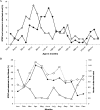Disease burden due to enterotoxigenic Escherichia coli in the first 2 years of life in an urban community in Bangladesh
- PMID: 17548483
- PMCID: PMC1951985
- DOI: 10.1128/IAI.00459-07
Disease burden due to enterotoxigenic Escherichia coli in the first 2 years of life in an urban community in Bangladesh
Abstract
A cohort of 321 children was followed from birth up to 2 years of age to determine the incidence of enterotoxigenic Escherichia coli (ETEC) in Bangladesh. The average number of diarrheal days and incidence rates were 6.6 and 2.3/child/year, respectively. ETEC was the most common pathogen and was isolated in 19.5% cases, with an incidence of 0.5 episode/child/year. The prevalence of rotavirus diarrhea was lower (10%). ETEC expressing the heat-stable enterotoxin (ST) was predominant. Strains isolated from diarrheal cases were positive for colonization factors (CFs) in higher frequency (66%) than from healthy children (33%) (P < 0.001). The heat-labile toxin (LT)-positive strains from healthy children were more often CF negative (92%) than those isolated from children with diarrhea (73%) (P < 0.001). In children with symptomatic or asymptomatic infections by CFA/I, CS1 plus CS3, CS2 plus CS3, or CS5 plus CS6 strains, a repeat episode of diarrhea or infection by the homologous CF type was uncommon. Repeat symptomatic infections were noted mostly for LT- and ST-expressing ETEC. ETEC diarrhea was more prevalent in children in the A and AB groups than in those in the O blood group (P = 0.032 to 0.023). Children with ETEC diarrhea were underweight and growth stunted at the 2-year follow-up period, showing the importance of strategies to prevent and decrease ETEC diarrheal morbidity in children.
Figures

References
-
- Ahren, C., C. Wenneras, J. Holmgren, and A. M. Svennerholm. 1993. Intestinal antibody response after oral immunization with a prototype cholera B subunit-colonization factor antigen enterotoxigenic Escherichia coli vaccine. Vaccine 11:929-934. - PubMed
-
- Bjork, S., M. E. Breimer, G. C. Hansson, K. A. Karlsson, and H. Leffler. 1987. Structures of blood group glycosphingolipids of human small intestine. A relation between the expression of fucolipids of epithelial cells and the ABO, Le and Se phenotype of the donor. J. Biol. Chem. 262:6758-6765. - PubMed
Publication types
MeSH terms
Substances
LinkOut - more resources
Full Text Sources
Medical
Miscellaneous

